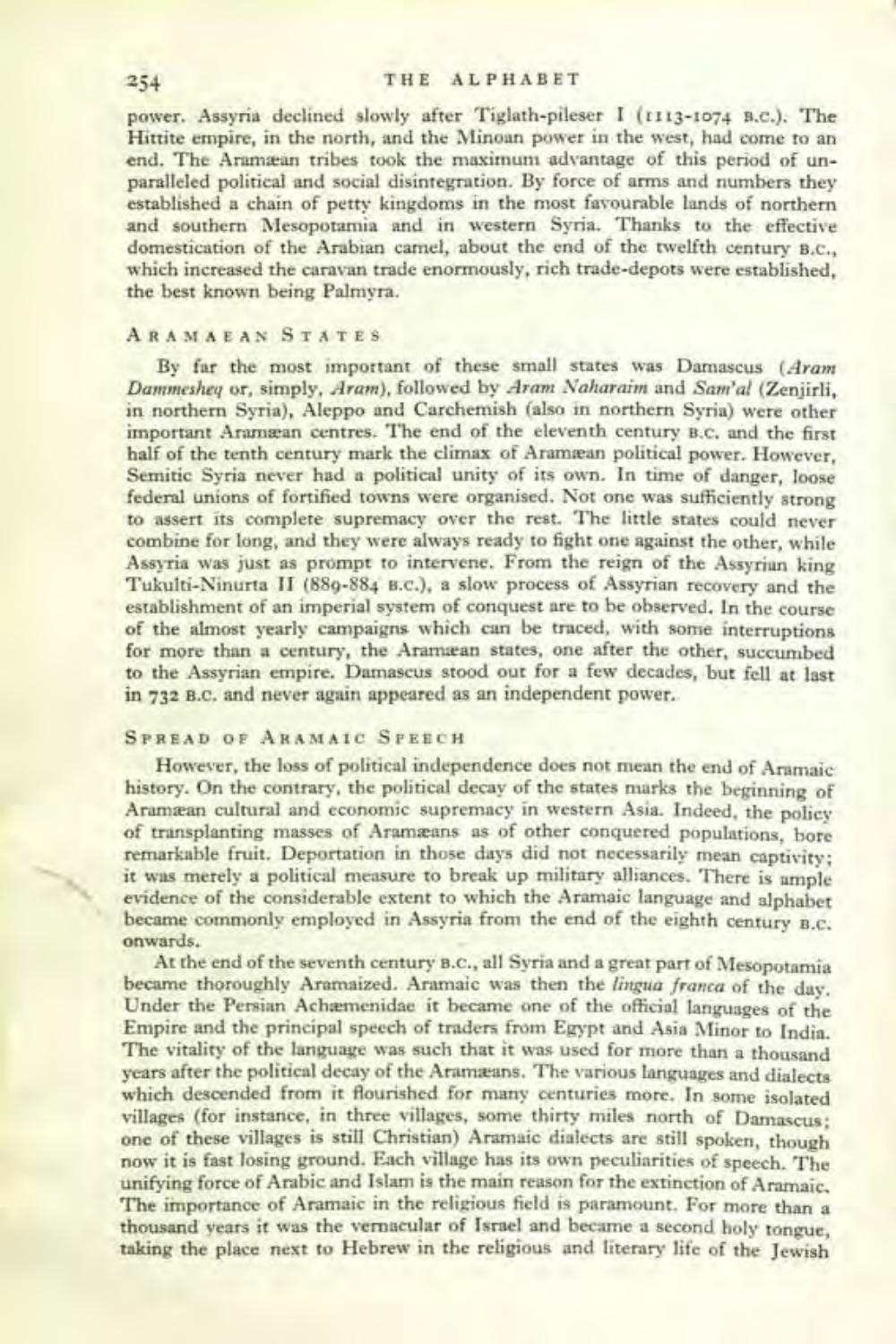________________
254
THE ALPHABET power. Assyria declined slowly after Tiglath-pileser I (1113-1074 B.C.). The Hittite empire, in the north, and the Minoan power in the west, had come to an end. The Aramaan tribes took the maximum advantage of this period of unparalleled political and social disintegration. By force of arms and numbers they established a chain of petty kingdoms in the most favourable lands of northern and southern Mesopotamia and in western Syria. Thanks to the effective domestication of the Arabian camel, about the end of the twelfth century B.C., which increased the caravan trade enormously, rich trade-depots were established, the best known being Palmyra.
ARAMAE AN STATES
By far the most important of these small states was Damascus (Aram Dammeshey or, simply, Aram), followed by Aram Maharaim and Sam'al (Zenjirli, in northern Syria), Aleppo and Carchemish (also in northern Syria) were other important Aramaan centres. The end of the eleventh century B.C. and the first half of the tenth century mark the climax of Aramkan political power. However, Semitic Syria never had a political unity of its own. In time of danger, loose federal unions of fortified towns were organised. Not one was sufficiently strong to assert its complete supremacy over the rest. The little states could never combine for long, and they were always ready to fight one against the other, while Assyria was just as prompt to intervene. From the reign of the Assyrian king Tukulti-Ninurta II (889-884 B.C.), a slow process of Assyrian recovery and the establishment of an imperial system of conquest are to be observed. In the course of the almost yearly campaigns which can be traced, with some interruptions for more than a century, the Aramaean states, one after the other, succumbed to the Assyrian empire. Damascus stood out for a few decades, but fell at last in 732 B.C. and never again appeared as an independent power.
SPREAD OF ARAMAIC SPEECH
However, the loss of political independence does not mean the end of Aramaic history. On the contrary, the political decay of the states marks the beginning of Aramaan cultural and economic supremacy in western Asia. Indeed, the policy of transplanting masses of Aramæans as of other conquered populations, bore remarkable fruit. Deportation in those days did not necessarily mean captivity: it was merely a political measure to break up military alliances. There is ample evidence of the considerable extent to which the Aramaic language and alphabet became commonly employed in Assyria from the end of the eighth century B.C. onwards.
At the end of the seventh century B.C., all Syria and a great part of Mesopotamia became thoroughly Aramaized. Aramaic was then the lingua franca of the day. Under the Persian Achaemenidae it became one of the official languages of the Empire and the principal speech of traders from Egypt and Asia Minor to India. The vitality of the language was such that it was used for more than a thousand years after the political decay of the Aramans. The various languages and dialects which descended from it flourished for many centuries more. In some isolated villages (for instance, in three villages, some thirty miles north of Damascus: one of these villages is still Christian) Aramaic dialects are still spokers, though now it is fast losing ground. Each village has its own peculiarities of speech. The unifying force of Arabic and Islam is the main reason for the extinction of Aramaica The importance of Aramaic in the religious field is paramount. For more than a thousand years it was the vernacular of Israel and became a second holy tongue taking the place next to Hebrew in the religious and literary life of the Jewish




